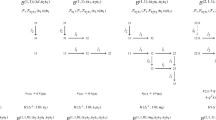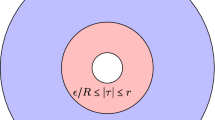Abstract
The Nash multiplicity sequence was defined by Lejeune-Jalabert as a non-increasing sequence of integers attached to a germ of a curve inside a germ of a hypersurface. Hickel generalized this notion and described a sequence of blow ups which allows us to compute it and study its behavior. In this paper, we show how this sequence can be used to compute some invariants that appear in algorithmic resolution of singularities. Moreover, this indicates that these invariants from constructive resolution are intrinsic to the variety since they can be read in terms of its space of arcs. This result is a first step connecting explicitly arc spaces and algorithmic resolution of singularities.
Similar content being viewed by others
Notes
W is just a variable in charge of the degree of the \(I_i\).
Here \(\nu _{\xi }(I)\) denotes the order of the ideal I in the regular local ring \(R_{{\mathcal {M}}_{\xi }}\), where \({\mathcal {M}}_{\xi }\) is the ideal defining the point \(\xi \).
Actually, the Hilbert–Samuel function has to be modified in order to be semicontinuous (see [2]). Here we refer to this modification of the Hilbert–Samuel function.
For simplicity, we will sometimes write \(\xi \) when we refer to the image of \(\xi ^{(n)}\) by most of the maps we use in this article. In particular, we will often write \({\mathrm {ord}}_{\xi }\) meaning \({\mathrm {ord}}_{\xi ^{(n)}}\) or \({\mathrm {ord}}_{\xi ^{(d)}}\).
Note that it is already differentially closed with respect to x.
No larger than the invariant \(\tau \) at \(\xi \), see [1] for more details.
This condition just means that the intersection of \(\mathrm {Ker}(d\beta )\) and the tangent space of \({\mathcal {G}}^{(n)}\) at \(\xi \) is 0. This guarantees that \(\beta \) induces a homeomorphism between \({\mathrm {Sing}}({\mathcal {G}}^{(n)})\) and \(\beta ({\mathrm {Sing}}({\mathcal {G}}^{(n)}))\).
For this, it suffices to have \({\mathcal {G}}^{(n)}\) differentially closed with respect to \(\beta \), that is, closed under the action of the sheaf of relative differential opperators \(\mathrm {Diff}_{V^{(n)}/V^{(n-e)}}\).
Note that we can always assume this situation for any \(\xi \in X\), since one can always consider a neighbourhood of \(\xi \) where this is true.
Therefore, for our purpose, we need to choose arcs in a way such that they are not contained in the set of points of highest multiplicity of X (that is, \(\varphi ^*(<0>)\nsubseteq {\mathrm {\underline{Max}\; mult}}(X)\)).
For simplicity of the notation, we will often identify the points \(\xi _i\) in \(X_i^{(d+1)}\) with their images in \(V_i^{(n+1)}\).
We use the same notation for the image of \(\xi \) by \(p*\) and by \(\bar{\delta }\).
\(C_0\) is a smooth curve in a local ring, and hence a complete intersection.
Note that \({\mathcal {G}}_{\varphi }\) and \({\mathcal {G}}_{\tilde{X}_0}^{(n+1)}\) are differentially closed by definition.
Note that \({\mathcal {G}}_{\varphi }^{(n+1)}\) has order one (see (4.7)).
As we have done already, we will write \(\xi \) for the image of \(\xi \) under most of the morphisms we use, as long as the identification between both points is clear.
Note that \(\mathrm {Ker}(\tilde{\Gamma }_0)=\mathrm {Ker}(\Gamma _0)({\mathcal {O}}_{V^{(n)},\xi }\otimes _{k} K[[t]])_{\xi _0}\).
If \(q\in R\) for a regular local ring R with maximal ideal \({\mathcal {M}}\), then we denote by \(\mathrm {in}_{\xi }(q)\) the initial part of q at the closed point \(\xi \), meaning the equivalence class of q in the quotient \({\mathcal {M}}^n/{\mathcal {M}}^{n+1}\), where n is such that \(q\in {\mathcal {M}}^n\) but \(q\notin {\mathcal {M}}^{n+1}\). Therefore \(\mathrm {in}_{\xi }(q)\in \mathrm {Gr}_{R_{{\mathcal {M}}}}\cong k'[z_1,\ldots ,z_d]\) is a homogeneous polynomial of degree n.
We know that such an arc exists by Remark 5.9.
References
Benito, A.: The tau-invariant and elimination. J. Algebra 324(8), 1903–1920 (2010)
Bennett, B.M.: On the characteristic functions of a local ring. Ann. Math. 91(2), 25–87 (1970)
Bierstone, E., Milman, P.: Canonical desingularization in characteristic zero by blowing up the maximum strata of a local invariant. Invent. Math. 128(2), 207–302 (1997)
Blanco, R., Encinas, S.: Coefficient and elimination algebras in resolution of singularities. Asian J. Math. 15(2), 251–271 (2011)
Bravo, A., Villamayor U, O.: Singularities in positive characteristic, stratification and simplification of the singular locus. Adv. Math. 224(4), 1349–1418 (2010)
Bravo, A., Villamayor U, O.E.: Elimination algebras and inductive arguments in resolution of singularities. Asian J. Math. 15(3), 321–355 (2011)
Bravo, A., García-Escamilla, M.L., Villamayor U, O.E.: On Rees algebras and invariants for singularities over perfect fields. Indiana Univ. Math. J. 61(3), 1201–1251 (2012)
Bravo, A., Villamayor U, O.E.: On the behavior of the multiplicity on schemes: stratification and blow-ups. The resolution of singular algebraic varieties. Clay Math. Proc. 20, 81–207 (2014)
Dade, E.C.: Multiplicity and monoidal transformations. Thesis (Ph.D.), Princeton University (1960)
Ein, L., Mustaţă, M., Yasuda, T.: Jet schemes, log discrepancies, and inversion of adjunction. Invent. Math. 153, 519–535 (2003)
Ein, L., Mustaţă, M.: Inversion of adjunction for local complete intersection varieties. Am. J. Math. 126, 1355–1365 (2004)
Ein, L., Mustaţă, M.: Jet schemes and singularities. Proc. Symp. Pure Math. 80(2), 505–546 (2009)
Encinas, S., Villamayor, O.: A course on constructive desingularization and equivariance. Resolution of singularities. Obergurgl: Progr. Math., vol. 181. Birkhäuser, Basel, pp 147–227 (1997)
Encinas, S., Villamayor, O.: A new proof of desingularization over fields of characteristic zero. Proceedings of the international conference on algebraic geometry and singularities (Spanish) (Sevilla, 2001). Rev. Mat. Iberoamericana 19(2), 339–353 (2003)
Encinas, S., Villamayor, O.: Rees algebras and resolution of singularities. Proceedings of the XVIth Latin American algebra colloquium (Spanish), (Colonia 2005). Bibl. Rev. Mat. Iberoamericana, Rev. Mat. Iberoamericana, Madrid, pp. 63–85 (2007)
Hickel, M.: Sur quelques aspects de la géométrie de l’espace des arcs tracés sur un espace analytique. Annales de la faculté des sciences de Toulouse Mathématiques (6) 14(1), 1–50 (2005)
Hironaka, H.: Resolution of singularities of an algebraic variety over a field of characteristic zero I, II. Ann. Math. 79(2), 109–326 (1964)
Hironaka, H.: Idealistic exponents of a singularity. J.J Sylvester Sympos., Baltimore, Md.: Algebraic Geometry. The Johns Hopkins Centennial Lectures, pp. 55–125. Johns Hopkins University Press, Baltimore, vol. 1977 (1976)
Ishii, S.: Geometric properties of jet schemes. Commun. Algebra 39(5), 1872–1882 (2011)
Lejeune-Jalabert, M.: Courbes Tracées sur un Germe D’Hypersurface. Am. J. Math. 112(4), 525–568 (1990)
Mustaţă, M.: Spaces of arcs in birational geometry. In: Lecture notes (available at the author’s personal web page)
Mustaţă, M.: Jet schemes of locally complete intersection canonical singularities, with an appendix by David Eisenbud and Edward Frenkel. Invent. Math. 145, 397–424 (2001)
Mustaţă, M.: Singularities of pairs via jet schemes. J. Am. Math. Soc. 15, 599–615 (2002)
Nobile, A.: Equivalence and resolution of singularities. J. Algebra 420, 161–185 (2014)
Villamayor U, O.E.: Constructiveness of Hironaka’s resolution. Ann. Sci. École. Norm. Sup 22(1), 1–32 (1989)
Villamayor U, O.E.: Patching local uniformizations. Ann. Sci. École. Norm. Sup. (4) 25(6), 629–677 (1992)
Villamayor, O.E.: Tschirnhausen transformations revisited and the multiplicity of the embedded hypersurface. In: Colloquium on Homology and Representation Theory (Spanish) (Vaquerías: Boletín de la Academia nacional de Ciencias, vol. 65, pp. 233–243. Córdoba, Argentina (2000)
Villamayor U, O.: Hypersurface singularities in positive characteristic. Adv. Math. 213(2), 687–733 (2007)
Villamayor U, O.: Rees algebras on smooth schemes: integral closure and higher differential operator. Rev. Mat. Iberoam. 24(1), 213–242 (2008)
Villamayor U, O.E.: Equimultiplicity, algebraic elimination, and blowing-up. Adv. Math. 262, 313–369 (2014)
Vojta, P.: Jets via Hasse–Schmidt derivations. In: Diophantine Geometry. CRM Series, 4th ed., pp. 335–361. Norm., Pisa (2007)
Acknowledgements
The authors profited from conversations with F. Aroca, R. Docampo, S. Ishii and H. Kawanoue, as well as from the support of their research team. We also thank C. Abad, J. Conde-Alonso and I. Efraimidis for their help with the presentation, and the referee for many useful suggestions.
Author information
Authors and Affiliations
Corresponding author
Additional information
A. Bravo, S. Encinas and B. Pascual-Escudero were partially supported by MTM2012-35849. B. Pascual-Escudero was supported by BES-2013-062656.
Rights and permissions
About this article
Cite this article
Bravo, A., Encinas, S. & Pascual-Escudero, B. Nash multiplicities and resolution invariants. Collect. Math. 68, 175–217 (2017). https://doi.org/10.1007/s13348-016-0188-9
Received:
Accepted:
Published:
Issue Date:
DOI: https://doi.org/10.1007/s13348-016-0188-9




